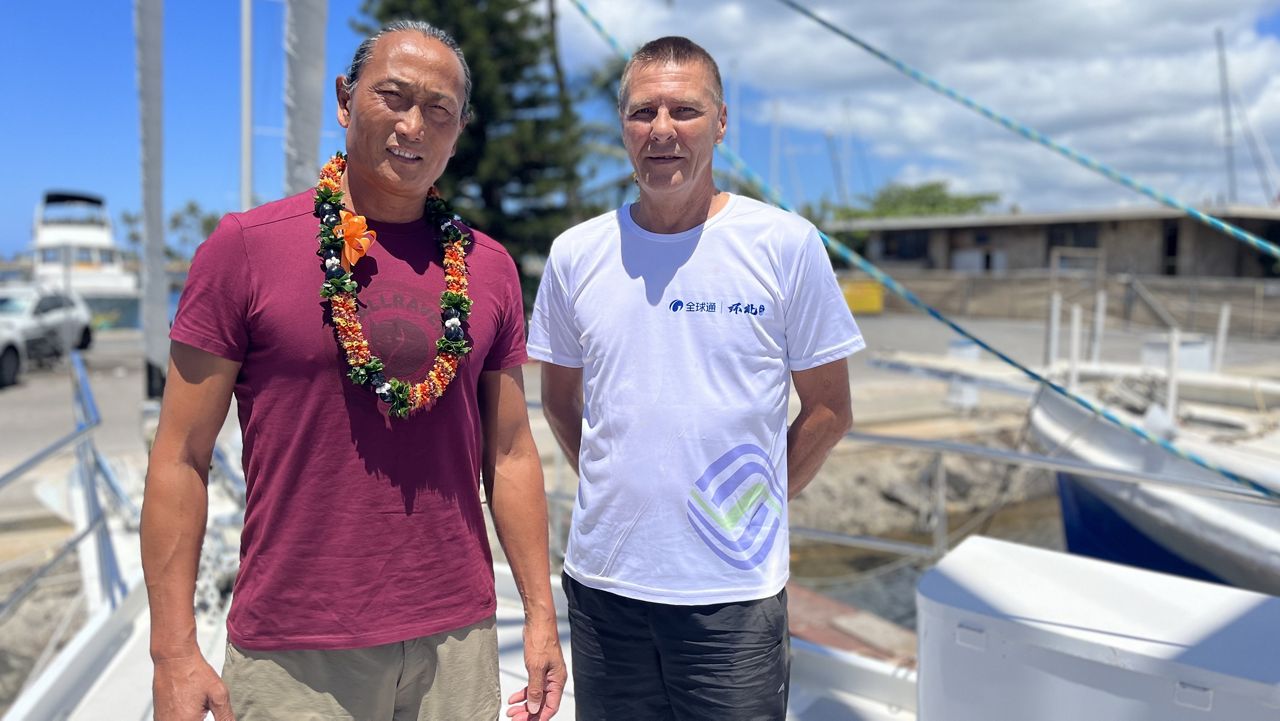HONOLULU — To the person unfamiliar with navigating such treacherous, arctic waters — virtually everyone, that is — the force of the collision would have seemed unlikely given the stillness of the moment that preceded it.
You might have said the boat had been advancing at glacial place if, in fact, the figurative held any meaning among the literal mountains of ice that lay in silent, invisible wait.
Captain Zhai Mo had been behind the wheel of the 80-foot boat, his two crewmen Mikhail Kotelnikov and Wang Tienan at either side of the bow, all scanning the surface of the water with a prolonged, unblinking, hyper-aware intensity known by soldiers and surgeons and sailors of the Arctic Circle.
How long had they been like that? Hours, of course. Days? The absence of night made it difficult to tell. The established rhythm of time — one asleep, two awake, two hours per rotation — had been suspended for this most delicate passage across the iceberg-laden ocean off Greenland and close to the North Pole.
Floating chunks of ice, some as big as cars, had been a challenge in other waters, but at least a visible one. Here the proverbial tips of icebergs did not always tower; sometimes they lurked just feet below the surface.
Zhai needn’t have warned his crew that they were entering a graveyard, a stretch of ocean upon which each iceberg served as a kind of tombstone to disastrously lost ambitions. They knew. How could they not?
Before leaving China months earlier, Zhai had stocked for a host of eventualities as best and as indulgently as possible. There was winter clothing, essential even for these sailors born for the cold. There was food to last, with tough rationing, a whole year should an accident disable the vessel long enough for the advancing ice to seize around it. There was a gun. For polar bears. Just in case.
The boat needed to advance slowly to give captain and crew a chance to see what lay immediately ahead. And yet there was urgency because waters they had crossed just two weeks earlier, at the crack in the brief window when ice melts just enough for a boat to cross, were already freezing over. Hurry or die. Hurry and die.
When the crash occurred, it was more felt than heard. Zhai shut down the boat and rushed to the cabin below to look for any sign of water. The crew lowered the sails and sped about, checking for damage.
The ship had brushed an iceberg hard enough to send provisions stored below off their shelves, enough to produce a small crack in the hull, but fortunately not enough to sink the vessel. The three men deployed manual and automatic pumps. The boat’s own automatic drainage system stood ready to protect against the water filling to a dangerous height.
They were lucky. Live-to-tell lucky.
The tale Zhai tells comes fitfully through thoughtful pauses and then rushes of fine detail, a local translator quickly jotting notes on a yellow legal pad and relaying the story in carefully chosen English. It’s months later, and the 53-year-old artist-turned-navigator is sipping hot Chinese tea from an oversized mug and allowing the still, humid Hawaiian air to settle on his darkly tanned skin. A small hammock of corded twine hanging nearby holds a small bounty of mango, papaya and oranges.
The collision had come nearly four months into an audacious attempt to circumnavigate the Arctic Circle in a sailboat. By that point, Zhai and his two crew members had left Shanghai, passed Korea, Japan, Russia, Norway and Iceland. It would be another month before they would be able to repair the ship, making an unscheduled stop in Gloucester, Mass., for several weeks.
Zhai had been dreaming of the voyage for some 20 years and had charted the entire course himself.
“This was unprecedented historically,” he says via the interpreter. “No one had ever done this. If you talked about this even 15 years ago, it would have seemed like a mission impossible. It is only possible now because of global warming.”“This was unprecedented historically,” he says via the interpreter. “No one had ever done this. If you talked about this even 15 years ago, it would have seemed like a mission impossible. It is only possible now because of global warming.”
Indeed, in the lead-up to his voyage, Zhai was recruited by the United Nations Educational, Scientific and Cultural Organization to serve as a climate ambassador and use his journey to raise awareness about climate change and the ocean.
The trip was not without its hiccups. There were disputes about rights of passage with both Russia and Canada. There were encounters with military jets from Russia, Denmark and Japan, all inquiring about Zhai’s route, plans and intentions.
Ultimately, Zhai elected to return to China from Massachusetts via Florida, Cuba and the Panama Canal. A stop in Hawaii was not originally planned, but once the new route was adopted, Zhai knew he had to return to a second home he had only visited once 14 years ago.
Well before Zhai became the most famous contemporary navigator in China, he was a successful and well-regarded artist who paintings were exhibited from France to Australia. It was during one such exhibition, in New Zealand, that Zhai got his first taste of sailing.
“I had my first contact with a sailing boat and I realized it was a transportation tool that provided freedom to travel the world,” he says. “So I bought a second-hand boat, less than 8 meters long. I basically floated for 28 days without knowing anything. I went from New Zealand to Tonga and Fiji and learned all about navigating and piloting along the way.”
An admirer of French artist Paul Gaugin, who famously spent a decade in French Polynesia, Zhai traveled spent two years traveling the South Pacific on his boat, experiencing the cultures of Tonga, Fiji, Tahiti, Samoa and New Caledonia with the eye of a painter and soul of an emerging navigator.
The experience inspired Zhai to attempt a solo circumnavigation of the globe. Leaving Shandong province in January 2007, Zhai sailed past the Philippines, Indonesia, Mozambique, the west coast of Italy, Brazil, Colombia, Venezuela, Panama and eventually landed in Hawaii.
Without a visa.
“Nobody knew I was coming until I arrived,” Zhai says. “I didn’t have a visa and the immigration official asked me how I could have come without one. I said it was not my plan; I was just blown here by the trade winds.”
After some brief confusion and a consultation with a supervisor, the official granted Zhai a six-month visa.
Zhai had a friend from Hawaii who introduced him to members of the local ex-pat Chinese community and Zhai himself made several new friends on his own as he spent five months repairing his boat and avoiding typhoon season in Asia.
Zhai says he felt an immediate connection to Hawaii because of its people, environment, and native culture. His return late last year felt like a long overdue homecoming.
With 20 years of expeditionary ocean travel under his drawstring, Zhai has had ample time to reflect on the ways his art and his ocean-faring have come to lathe each other. There are ocean elements visible in his art, to be sure, but the interplay is so much deeper, he says.
“Each time I navigate the ocean, I feel I can sense something, like I have a metaphysical feeling for what is going to happen,” he says. “It is my wish that I can use the extreme way or approach of my navigation experience to create art in my own vision.”
Zhai’s circumnavigation of the globe was a major event in China, raising the profile of sailing in a county with relatively little awareness of the sport. Sailing, particularly laser boat racing, is now a burgeoning industry in China and Zhai is widely viewed as its pioneer.
Zhai appreciates the credit but said he wants to remind people that China has a long and distinguished navigational history. China, after all, is believed to have invented the magnetic compass and there is archeological evidence of a shipyard existing in Guanzhou as far back as 200 BC.
There will be plenty of opportunity for Zhai to command his country’s attention. If all goes well, Zhai will embark on a new adventure next year to retrace the voyage of the Empress of China, an American merchant vessel that traveled from New York to China in 1784, effectively opening trade between the U.S. and China. Before the year is out, he also plans to circumnavigate Antarctica, a voyage he had originally hoped to include in last year’s arctic trip.
“Trips are the blueprint for my life,” Zhai says, with a nod of emphasis and a quick laugh.“Trips are the blueprint for my life,” Zhai says, with a nod of emphasis and a quick laugh.
The immediate plan, however, is for Zhai to unmoor his boat from its temporary home at the Ala Wai Boat Harbor and sail back to Shandong with his wife and 10-year-old son, who have flown in to meet him.
Leaving will be difficult, he admits. He likes it here. Good geomancy, he says, good Feng Shui.
“I have a destiny to be affiliated with Hawaii,” he says. “I always say I was blown here by the wind.”
Michael Tsai covers local and state politics for Spectrum News Hawaii.









